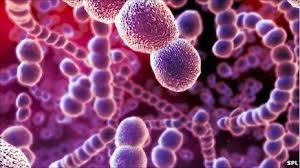BACTERIA
Bacteria are a large domain of procariotic
microorganism. Bacteria are often maligned as the causes of human and animal
disease (like this one, Leptospira, which causes serious disease in
livestock). However, certain bacteria, the actinomycetes, produce antibiotics
such as streptomycin and nocardicin; others live symbiotically in the guts of
animals (including humans) or elsewhere in their bodies, or on the roots of
certain plants, converting nitrogen into a usable form. Bacteria put the tang in
yogurt and the sour in sourdough
bread; bacteria help to break down dead
organic matter; bacteria make up the base of the food web in many environments.
Bacteria are of such immense importance because of their extreme flexibility,
capacity for rapid growth and reproduction, and great age - the oldest fossils
known, nearly 3.5 billion years old, are fossils of bacteria-like organisms.
Properties
of Bacteria
- prokaryotic (no membrane-enclosed nucleus)
- no mitochondria or chloroplasts
- a single chromosome
- If flagella are present, they are made of a single filament of the protein flagellin
- ribosomes differ in their structure from those of eukaryotes
Classification of Bacteria
shape
- bacilli: rod-shaped
- cocci: spherical
- spirilla: curved walls
The Gram stain is named after the 19th
century Danish bacteriologist who developed it.
- The bacterial cells are first stained with a purple dye called crystal violet.
- Then the preparation is treated with alcohol or acetone.
- This washes the stain out of Gram-negative cells.
- To see them now requires the use of a counterstain of a different color (e.g., the pink of safranin).
- Bacteria that are not decolorized by the alcohol/acetone wash are Gram-positive.
Bacterial
Cell Structure
Internal Structure: Bacteria have a very simple internal structure, and
no membrane-bound organelles.
1.
Nucleoid
DNA in the bacterial cell is generally confined to
this central region. Though it isn't bounded by a membrane, it is visibly
distinct (by transmission microscopy) from the rest of the cell interior.
2.
Ribosomes
Ribosomes give the cytoplasm of bacteria a granular
appearance in electron micrographs. Though smaller than the ribosomes in
eukaryotic cells, these inclusions have a similar function in translating the
genetic message in messenger RNA into the production of peptide sequences
(proteins).
3.
storage granules
(not shown) Nutrients and reserves may be stored in
the cytoplasm in the form of glycogen, lipids, polyphosphate, or in some cases,
sulfur or nitrogen.
4.
Endospore
(not shown) Some bacteria, like Clostridium botulinum,
form spores that are highly resistant to drought, high temperature and other
environmental hazards. Once the hazard is removed, the spore germinates to
create a new population.
Surface Structure: Beginning from the outermost
structure and moving inward, bacteria have some or all of the following
structures:
1.
Capsule
This layer of polysaccharide (sometimes proteins)
protects the bacterial cell and is often associated with pathogenic bacteria
because it serves as a barrier against phagocytosis by white blood cells.
2.
outer membrane
(not shown) This lipid bilayer is found in Gram
negative bacteria and is the source of lipopolysaccharide (LPS) in these
bacteria. LPS is toxic and turns on the immune system of , but not in Gram
positive bacteria.
3.
cell wall
Composed of peptidoglycan (polysaccharides + protein),
the cell wall maintains the overall shape of a bacterial cell. The three
primary shapes in bacteria are coccus (spherical), bacillus (rod-shaped) and
spirillum (spiral). Mycoplasma are bacteria that have no cell wall and
therefore have no definite shape.
4.
plasma membrane
This is a lipid bilayer much like the cytoplasmic
(plasma) membrane of other cells. There are numerous proteins moving within or
upon this layer that are primarily responsible for transport of ions, nutrients
and waste across the membrane.



























0 comments:
Post a Comment